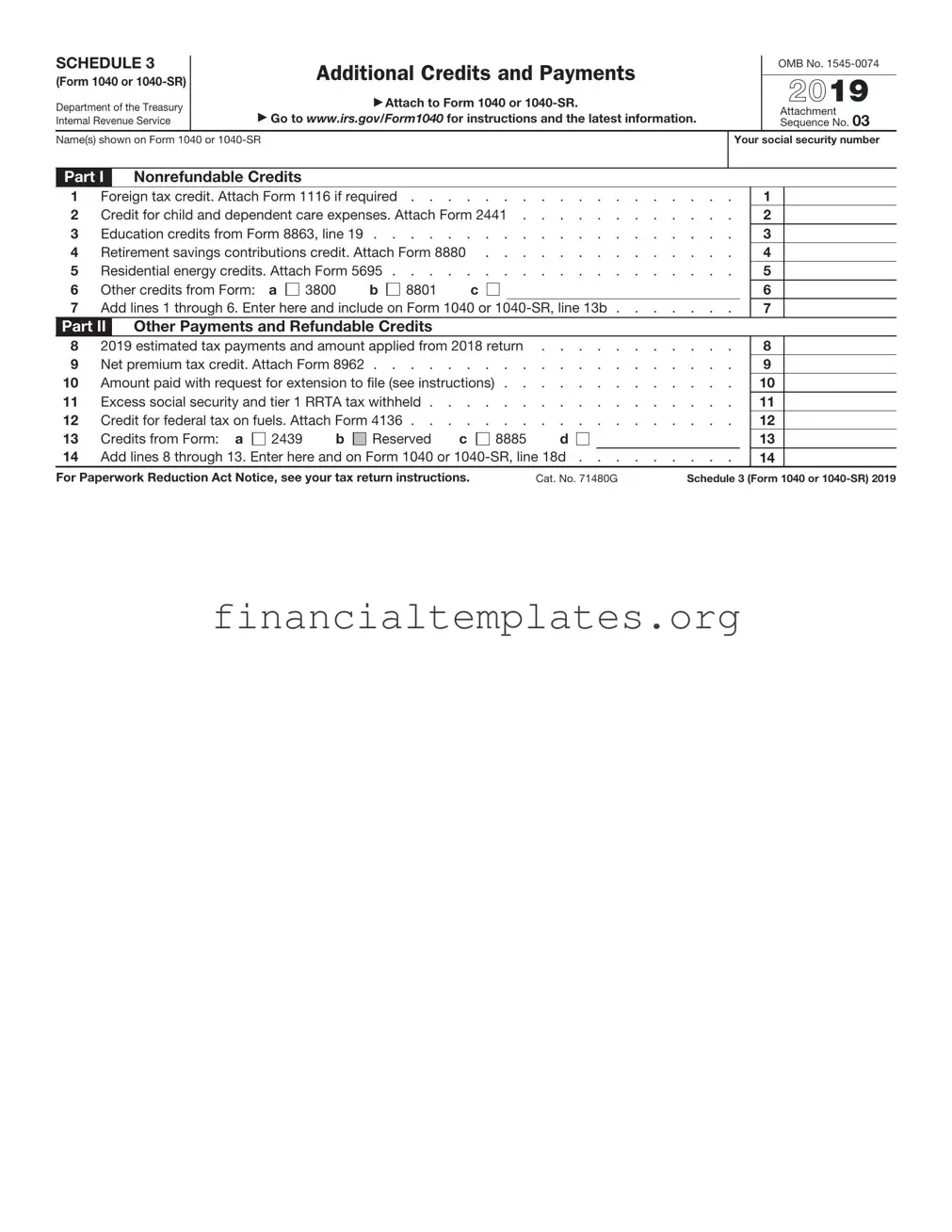The IRS Form 1040 is the foundational document that the IRS Schedule 3 1040 or 1040-SR form complements. It is the standard federal income tax form used by residents for filing their annual income tax returns. The Form 1040 collects basic information about the taxpayer's income, tax deductions, and credits to calculate the amount of tax owed or the refund due. Schedule 3, attached to this form, is specifically designed for reporting additional credits and payments not captured in the main form.
IRS Schedule 1 (Form 1040 or 1040-SR) bears similarity to Schedule 3 in that it is an additional form used by taxpayers to report specific types of income or adjustments not covered in the main Form 1040. Whereas Schedule 3 focuses on additional credits, Schedule 1 is mainly concerned with additional income and adjustments to income. This includes income from rental properties, business income, alimony received, and deductible part of self-employment tax.
IRS Schedule 2 (Form 1040 or 1040-SR) is another related document, akin to Schedule 3, used to report additional taxes that are not entered directly on Form 1040. This includes the Alternative Minimum Tax or specific other taxes like those on investments. Schedule 2 and Schedule 3 are complementary, with Schedule 2 focusing on additional taxes owed, and Schedule 3 on additional credits to offset those taxes.
IRS Schedule 4 (Form 1040), previously used in tax years before 2020, was similar to Schedule 3 in its function of reporting certain taxes. Although it has since been consolidated into Schedules 2 and 3 in the redesigned Form 1040, it historically related to Schedule 3 by dealing with taxes not directly reported on the Form 1040, such as self-employment tax and additional retirement account taxes.
The IRS Schedule A (Form 1040) resembles Schedule 3 in that it provides a platform for taxpayers to itemize their deductions, but its focus is primarily on deductions rather than credits. Schedule A includes specific expenses such as medical, dental, taxes paid, home mortgage interest, and charitable contributions. Taxpayers use it to potentially reduce their taxable income in contrast to the tax credits reported on Schedule 3.
The IRS Schedule E (Form 1040) is a form that, like Schedule 3, attaches to the primary Form 1040 for specific reporting purposes. Schedule E focuses on supplemental income and loss, particularly from rental real estate, royalties, partnerships, S corporations, estates, trusts, and residual interests in REMICs. It complements Schedule 3 by accounting for types of income that can affect a taxpayer’s overall tax situation and potential credits.
IRS Schedule D (Form 1040) has a focused purpose similar to that of Schedule 3, but it deals with the reporting of capital gains and losses from the sale or exchange of certain property. Taxpayers use Schedule D to calculate the tax on capital gains, which can then interact with credits reported on Schedule 3 to potentially reduce the overall tax liability.
The IRS Form 8863, titled "Education Credits (American Opportunity and Lifetime Learning Credits)," is a document that relates closely to Schedule 3 through its focus on tax credits. Specifically, it’s used to calculate and claim educational credits that directly reduce the amount of tax owed, not just the income subject to tax. These credits, once calculated on Form 8863, are then reported on Schedule 3.
IRS Form 2441, "Child and Dependent Care Expenses," is another form compatible with the intent behind Schedule 3. It allows taxpayers to calculate the credit for child and dependent care expenses, which can significantly reduce their tax liability. The credit calculated on Form 2441 is ultimately reported on Schedule 3, highlighting the interconnected nature of these forms in facilitating tax credits.
Lastly, IRS Form 8962, "Premium Tax Credit," shares the goal of Schedule 3 by providing a means to claim tax credits, in this case, those related to health insurance premiums for plans purchased through the Health Insurance Marketplace. Taxpayers use Form 8962 to calculate their Premium Tax Credit. The computed credit can then be reported on Schedule 3 to adjust the overall tax due or increase the refund.

